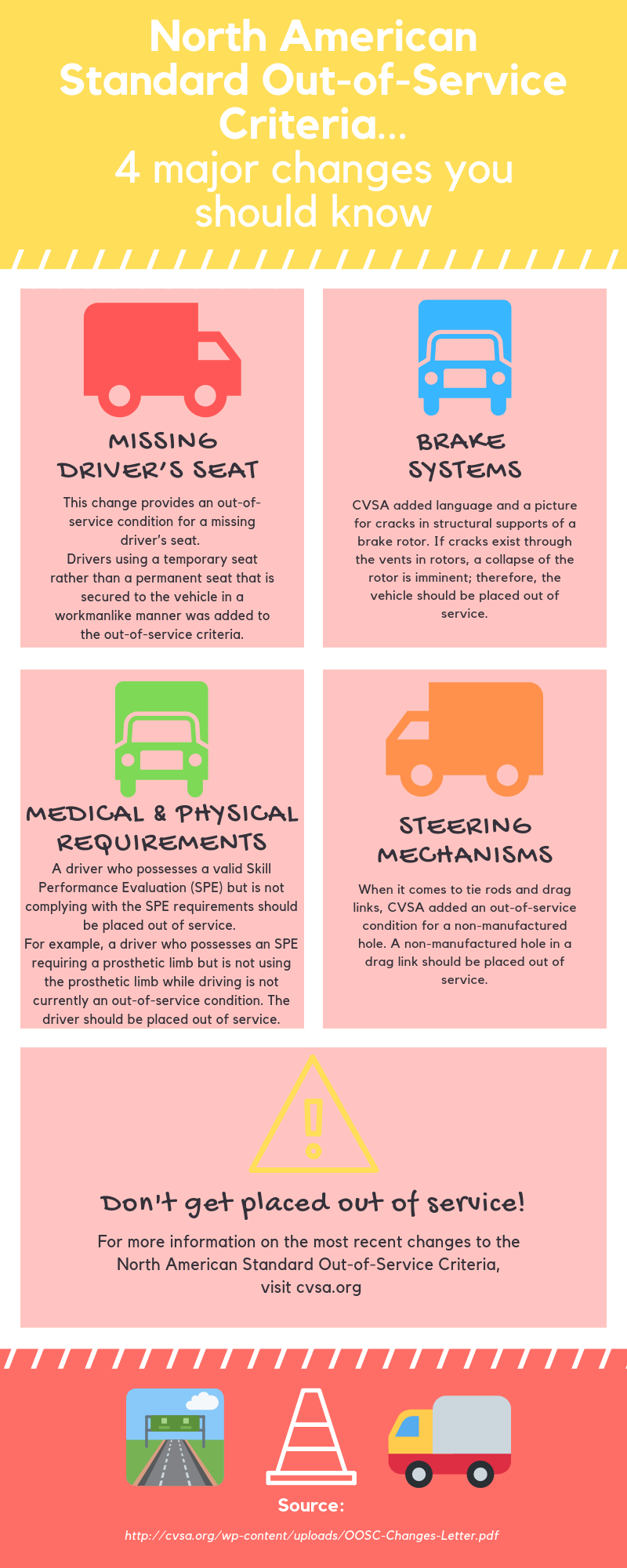Could any of these 4 violations put you out of service?
Here at the PDQ Transmitter, we pride ourselves on keeping you updated with important industry news and insights. This week, we’re keeping you informed about 4 recently revised criteria that could put your truck out of service, demystifying personal conveyance time, and considering whether the ELD mandate has really had much of an impact on road safety.
Let’s get to it!
We’re now rolling through the second week of April, but as of April 1, truckers could be placed out of service for 4 recently-changed violations. Are you up to date on Commercial Vehicle Safety Alliance (CVSA) out of service criteria?
If not, we’ll catch you up!
Here are four major out of service changes that took effect at the beginning of the month:
It’s also important to note CVSA determined that it is “most appropriate” to remove an expired CVSA decal before applying a new decal. According to CVSA, “Covering up expired decals is problematic because colors can show on the corners and new decals can be removed by layering them on the vehicle.”
For the full explanation of CVSA’s updated out of service criteria, click here.
Demystifying conveyance time
Personal conveyance time can be confusing for some in the trucking industry, but according to Joe DeLorenzo, FMCSA’s director of enforcement and compliance, it’s actually quite simple.
“Am I off duty? Am I doing any work at the request of the motor carrier, rather than for myself? Is the major purpose of why the motor vehicle is being moved personal? Is it for a nonbusiness-related purpose?”
DeLorenzo gave these remarks during an electronic logging device update session at the Mid-America Trucking Show at the end of March.
He said the following include instances when drivers would use personal conveyance time include:
traveling to lodging
driving to restaurants or entertainment venues
time spent traveling to a reasonable, safe location to obtain required rest
moving a truck at the request of a safety official during the driver’s off-duty time
Drivers don’t have to worry about certain time or distance limits for legitimate personal use movement of commercial motor vehicles, according to Transport Topics. However, DeLorenzo stated that drivers can’t use personal conveyance for work-related purposes like advancing the freight or transporting a vehicle to a facility for maintenance.
“It doesn’t matter what you’re hauling or whether you’re loaded or unloaded or hooked up to a trailer or not,” DeLorenzo said. “You can move the vehicle to the nearest safe location on personal conveyance time to get rest, and you don’t have to go backwards.”
“This is one of those times where it’s OK to continue on the progress of the load as long as you are stopping at the nearest reasonable, safe location. We deliberately don’t define that because that’s a judgment call on the part of the driver.”
New research suggests ELD mandate had no significant impact on crash rates
Although the ELD mandate has been proven to help with hours of service (HOS) compliance, new research indicates little progress has been made in regard to safety.
Researchers from three different universities, including Northeastern University, University of Arkansas and Michigan State University, completed a study in January about whether or not the ELD mandate reduced crashes, according to FreightWaves.com
The researchers looked at millions of driver inspections between January 2017 and September 2018, investigating all the crashes submitted by the states to the Federal Motor Carrier Safety Administration (FMCSA), said Dave Osiecki, president of Scopelitis Transportation Consulting.
Spireon recently hosted a webinar in collaboration with FreightWaves called “The State of the Industry and the ELD Mandate: The Verdict One Year Later,” featuring Dave Osiecki, president of Scopelitis Transportation Consulting, and FreightWaves’ Chief Insight Officer Dean Croke.
One of the main purposes of this webinar was to help those in the trucking industry better understand the study’s findings, and the impact (or lack thereof) of ELDs on safety and crash rates.
While the ELD mandate has increased HOS compliance overall, it hasn’t really impacted crash counts. Check out these statistics:
Weekly crashes prior to mandate averaged 1,717.
During the light enforcement period, weekly crashes increased to 1,912, or 11.4 percent.
During the strict enforcement period, weekly crashes dropped to 1,703, or 0.8 percent.
Research also revealed that owner-operators and drivers for small carriers were cited much more frequently for unsafe driving behaviors after the mandate.
Do you think the ELD mandate unfairly singles out smaller carriers and owner-operators? Or do you think it’s been a useful tool in ensuring HOS compliance? Comment and tell us what you think!

